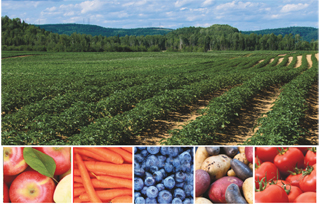New Brunswick
While its much larger sibling, Quebec, is a French-speaking province, New Brunswick is constitutionally bilingual, with residents speaking both English and French. And although this maritime province consists of only 28,150 square miles (72,908 square kilometers), there are some 3,000 farms in New Brunswick, generating $400 million in farm cash receipts each year.
Despite the province’s snowy, frigid winters, New Brunswick is a notable producer of apples, blueberries, cranberries, strawberries, and potatoes, which are primarily grown in the St. John River Valley.
Wild blueberries are one of the fastest growing commodities in the province, with an annual revenue increase of 25 percent a year in the last decade. Value has more than tripled over the past ten years, reaching over $30 million annually.
New Brunswick’s top crop, however, remains potatoes. In 2014, the province harvested 48,050 acres with an average yield of just under 300 hundredweight per acre, and total production reached 14.3 million hundredweight for the year, up from 13.7 million hundredweight in 2013.
Nova Scotia
Nova Scotia is a Maritime province, along with New Brunswick and Prince Edward Island. Known as “Canada’s Ocean Playground,” its agriculture sector continues to grow incrementally, especially in fruit such as berries and apples.
While Nova Scotia is most well-known for the blueberries and apples grown in its Annapolis Valley region, it is also a major strawberry producer, typically accounting for 7 percent of Canada’s overall strawberry output. Unfortunately, the province’s strawberry production plummeted in 2013 due to a virus outbreak in the fields. The relatively new disease, a complex combination of two known viruses, was spread by a small insect called the strawberry aphid. The virus weakened the plants, causing either undesirably small berries or preventing plants from flowering altogether. Growers were forced to plow under almost a third of their strawberry fields in 2013 due to virus damage.
In December 2013, the Canada-Nova Scotia Strawberry Assistance Initiative provided $2.3 million to assist strawberry producers affected by the virus with the one-time extraordinary cost of removing and replacing plants. As a result, the province’s strawberry production began to bounce back in 2014, although official numbers are not yet available.
In addition to its famous fruit, Nova Scotia’s field and greenhouse vegetables are also on the rise. From 2012 to 2013, cash receipts for greenhouse vegetables skyrocketed by 53 percent to $7.8 million and field vegetables jumped by 23 percent to $26.1 million. Nova Scotia’s greenhouse tomato production increased by 38 percent in 2013, and production of greenhouse cucumbers increased by more than 40 percent.



